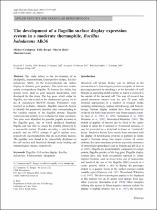 ResearchSpace
ResearchSpace
Development of a flagellin surface display expression system in a moderate thermophile, Bacillus halodurans Alk36
JavaScript is disabled for your browser. Some features of this site may not work without it.
- ResearchSpace
- →
- Research Publications/Outputs
- →
- Journal Articles
- →
- View Item
| dc.contributor.author |
Crampton, Michael C

|
|
| dc.contributor.author |
Berger, E

|
|
| dc.contributor.author |
Reid, S

|
|
| dc.contributor.author |
Louw, M

|
|
| dc.date.accessioned | 2007-07-26T07:31:08Z | |
| dc.date.available | 2007-07-26T07:31:08Z | |
| dc.date.issued | 2007-06 | |
| dc.identifier.citation | Crampton, M.C., Berger, E., Reid, S. and Louw, M. 2007. Development of a flagellin surface display expression system in a moderate thermophile, Bacillus halodurans Alk36. Applied Microbiology and Biotechnology, Vol 75(3), pp 599-607 | en |
| dc.identifier.issn | 0175-7598 | |
| dc.identifier.uri | http://hdl.handle.net/10204/1037 | |
| dc.description | Copyright: 2007 Springer Verlag | en |
| dc.description.abstract | This study relates to the development of an alkaliphilic, thermotolerant, Gram-positive isolate, Bacillus halodurans Alk36, for the over-production and surface display of chimeric gene products. This bacterium continuously over-produces flagellin. To harness this ability, key genetic tools, such as gene targeted inactivation, were developed for this strain. The hag gene, which codes for flagellin, was inactivated on the chromosome giving rise to the B. halodurans BhFC01 mutant. Polylinkers were inserted as in-frame, chimeric, flagellin sandwich fusions to identify the permissive insertion sites corresponding to the variable regions of the flagellin protein. Flagellin expression and motility were evaluated for these constructs. Two sites were identified for possible peptide insertion in the flagellin gene, one of which produced functional flagella and was able to restore the motility phenotype to a non-motile mutant. Peptides encoding a poly-histidine peptide and the HIV-1 subtype C gp120 epitope were, respectively, incorporated into this site as in-frame fusions. The peptides were found to be successfully displayed on the cell surface and functional through metal binding and immunological studies, respectively | en |
| dc.language.iso | en | en |
| dc.publisher | Springer Verlag | en |
| dc.subject | Flagellin | en |
| dc.subject | Cell surface display | en |
| dc.subject | Bacillus halodurans | en |
| dc.subject | Fusion protein | en |
| dc.subject | Integration | en |
| dc.title | Development of a flagellin surface display expression system in a moderate thermophile, Bacillus halodurans Alk36 | en |
| dc.type | Article | en |
| dc.identifier.apacitation | Crampton, M. C., Berger, E., Reid, S., & Louw, M. (2007). Development of a flagellin surface display expression system in a moderate thermophile, Bacillus halodurans Alk36. http://hdl.handle.net/10204/1037 | en_ZA |
| dc.identifier.chicagocitation | Crampton, Michael C, E Berger, S Reid, and M Louw "Development of a flagellin surface display expression system in a moderate thermophile, Bacillus halodurans Alk36." (2007) http://hdl.handle.net/10204/1037 | en_ZA |
| dc.identifier.vancouvercitation | Crampton MC, Berger E, Reid S, Louw M. Development of a flagellin surface display expression system in a moderate thermophile, Bacillus halodurans Alk36. 2007; http://hdl.handle.net/10204/1037. | en_ZA |
| dc.identifier.ris | TY - Article AU - Crampton, Michael C AU - Berger, E AU - Reid, S AU - Louw, M AB - This study relates to the development of an alkaliphilic, thermotolerant, Gram-positive isolate, Bacillus halodurans Alk36, for the over-production and surface display of chimeric gene products. This bacterium continuously over-produces flagellin. To harness this ability, key genetic tools, such as gene targeted inactivation, were developed for this strain. The hag gene, which codes for flagellin, was inactivated on the chromosome giving rise to the B. halodurans BhFC01 mutant. Polylinkers were inserted as in-frame, chimeric, flagellin sandwich fusions to identify the permissive insertion sites corresponding to the variable regions of the flagellin protein. Flagellin expression and motility were evaluated for these constructs. Two sites were identified for possible peptide insertion in the flagellin gene, one of which produced functional flagella and was able to restore the motility phenotype to a non-motile mutant. Peptides encoding a poly-histidine peptide and the HIV-1 subtype C gp120 epitope were, respectively, incorporated into this site as in-frame fusions. The peptides were found to be successfully displayed on the cell surface and functional through metal binding and immunological studies, respectively DA - 2007-06 DB - ResearchSpace DP - CSIR KW - Flagellin KW - Cell surface display KW - Bacillus halodurans KW - Fusion protein KW - Integration LK - https://researchspace.csir.co.za PY - 2007 SM - 0175-7598 T1 - Development of a flagellin surface display expression system in a moderate thermophile, Bacillus halodurans Alk36 TI - Development of a flagellin surface display expression system in a moderate thermophile, Bacillus halodurans Alk36 UR - http://hdl.handle.net/10204/1037 ER - | en_ZA |





